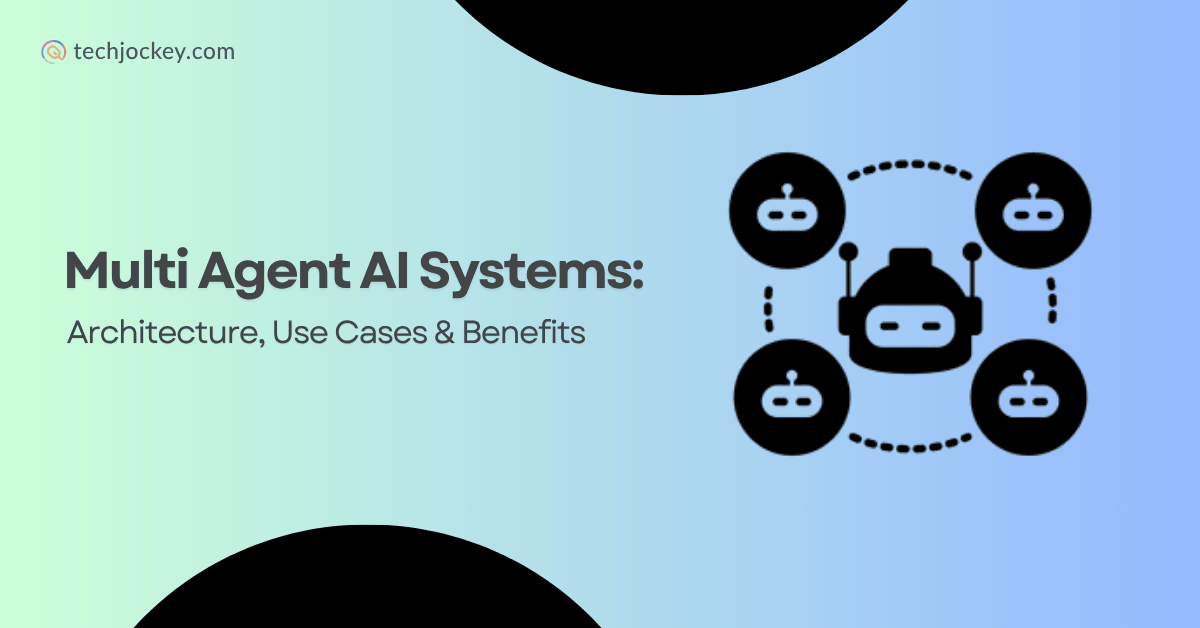
Artificial intelligence is growing so fast and will grow and grow more faster in the coming time. The competition is so high in the agentic AI tools market that multi-agent AI is a new entry in it.
Some reports say that the multi-agent system platform market is likely to grow from about USD 7.81 billion in 2025 to nearly USD 54.91 billion by 2030. When calculating CAGR, it goes around 47-48% this way.
Meanwhile, the broader agentic AI market is about to surge from roughly USD 6–7 billion in 2024–25 to above USD 40–100 billion, maybe within the next 5 to 8 years.
This clearly shows that businesses are moving quickly from experimenting with AI agents to building coordinated networks of agents capable of autonomous decision-making.
In this post, we will learn about multi-agent AI, how it works, and how it is different from single-agent AI. Let’s begin.
A multi-agent system in AI is a system of autonomous agents that are interacting in a common environment. Each agent views its environment independently, decides, and acts in order to achieve a certain objective.
However, the main power of MAS is the ‘collective intelligence’ of multiple agents. It’s their ability to coordinate actions and share knowledge to accomplish complex tasks more effectively.
An AI agent is a program or model that performs tasks for a user or another system. Today’s agents use large language models (LLMs), which enable them to understand natural language, plan multiple steps, use external tools or APIs, and improve based on feedback.
When several such agents are in combination, they constitute a MAS that is able to plan, reason, and perform tasks at scale independently.
This is what a multi-agent AI system is!
The single-agent system is entirely autonomous. It is driven by data and tools to complete a task without involving or communicating with other agents. As an example, a chatbot answering frequently asked questions or a system that recommends products.
Conversely, a multi-agent AI comprises numerous independent agents cooperating or in some cases competing within the same environment. Agents have their individual competencies and objectives, yet assist one another in accomplishing a shared objective. These agents are able to communicate, exchange knowledge, and learn among themselves. This is known as multi-agent reinforcement learning.
Multi-agent systems function through distributed intelligence and structured collaboration. Here’s how they operate:
Every MAS consists of three fundamental components:
Multi-agent AI systems can be set up in different ways based on how agents coordinate and how independent they are.
1. Centralized Architecture
In this setup, one main controller manages all communication and decisions. It’s simple to coordinate, but if the main unit fails, the whole system can stop working.
2. Decentralized Architecture
Here, agents talk directly to each other instead of relying on a central controller. This makes the system stronger and more fault-tolerant, but coordination becomes more challenging.
3. Hierarchical and Holonic Structures
4. Coalition and Team Structures
The dynamics of MAS often resemble natural behaviors seen in biological systems:
Flocking: Agents move or make decisions using simple heuristics:
This is applied in robotic swarm navigation and traffic flow optimization.
Swarming: Agents organize themselves and act in sync, much like bees or birds in a swarm. This decentralized teamwork helps systems handle large-scale tasks and control groups of robots easily.
Below are some real-world applications of multi-agent systems in artificial intelligence:
Although MAS has tremendous potential, it also comes with challenges. Below are a few discussed:
It is difficult to coordinate a large number of independent agents when their interests are conflicting or when the environment changes rapidly.
Sometimes, when there are too many agents sharing data simultaneously, the system may slow down.
There are certain times when agent interactions may produce unpredictable or unstable outcomes that were not intended.
In sensitive systems, a faulty or malicious agent can cause disruptions or data leaks, raising security concerns.
Large AI-based agents require high-end computing resources, which raises the cost of operations. Also, finding and fixing errors is complex because agents depend on each other’s actions.
Several open-source frameworks help developers design, test, and deploy MAS efficiently:
1. JADE (Java Agent Development Framework): A FIPA-compliant toolkit for building agent-based systems, primarily for academic and business simulations.
2. Mesa (Python): Ideal for modeling and visualizing agent-based simulations such as crowd dynamics or ecosystem behavior.
3. Ray (Python): A high-performance distributed computing framework used to scale AI workloads and manage agent coordination.
4. AutoGen (Microsoft): Enables creation of LLM-based ‘conversable agents’ that collaborate on software development or code analysis tasks.
5. CrewAI: Simplifies building AI ‘teams’ (like a writer, editor, and researcher) that work together to complete structured workflows.
CrewAI
Starting Price
$ 25.00
6. LangGraph and LangChain: Provide graph-based orchestration and modular tools to build context-aware, stateful agent networks.
7. LlamaIndex: Connects agents to external data sources, enhancing retrieval-augmented generation and data-driven reasoning.
Future of Multi-Agent Systems
As AI systems evolve, MAS will form the backbone of intelligent automation. With better orchestration tools, memory management, and real-time reasoning, MAS can soon manage entire workflows with minimal human intervention.
The future points toward self-organizing, learning-driven ecosystems of agents that cooperate not just within one system but across digital platforms. It marks a major leap toward collective artificial intelligence.
Online shopping is changing fast. With the advent of AI assistants, in fact, the way… Read More
Did you know cyberattacks hit business every 39 seconds? That’s right. Every minute counts… Read More
Hackers can’t just keep away by using strong passwords. Here’s the proof: Research says that… Read More
There’s new contender in the smart browser race. A few months after the launch… Read More
AI is advancing at an unimaginable pace. This necessitates reimagining of how this intelligence… Read More
Cyber threats exploiting web traffic are increasing by the minute, and so is the need… Read More